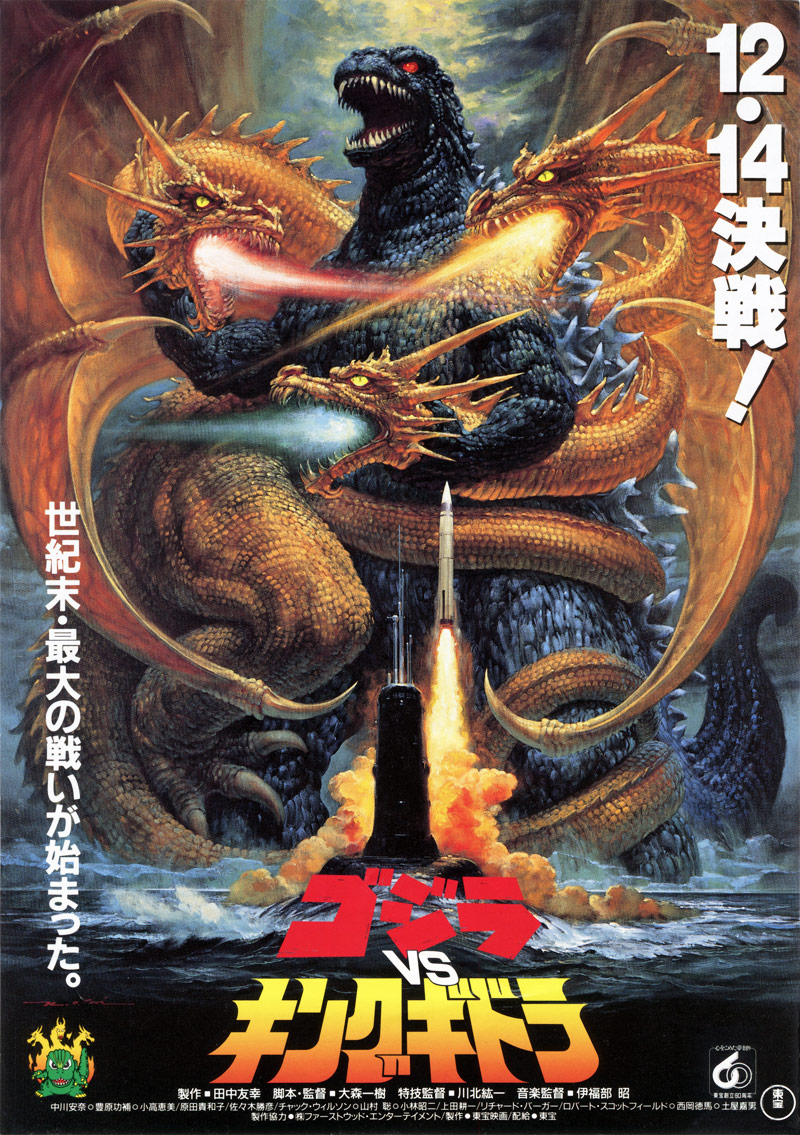ゴジラVSキングギドラ
Godzilla vs. King Ghidorah

Stats & Staff
Release: December 14th, 1991
Produced by: Tomoyuki Tanaka & Shogo Tomiyama
Written by: Kazuki Omori
Directed by: Kazuki Omori & Koichi Kawakita
Composed by: Akira Ifukube
Runtime: 102 minutes
Appearances
Monsters: Godzilla (3rd Generation), King Ghidorah (2nd Generation), Godzillasaurus (Lagos), Dorat (Ichiro, Jiro, & Saburo), Mecha-King Ghidorah
Mecha: Maser Cannons (MBT-MB92)
Story
Synopsis: A UFO appears over Japan in 1992, which soon reveals itself to be a time machine carrying passengers from the 23rd century. According to the Futurians, by there time, Japan is a nuclear wasteland unfit for life due to the rampages of Godzilla. They propose a plan based on the book The Birth of Godzilla, which has only just started the research stage at this point in history, to prevent Godzilla's creation. The hypothesis of the book is that Godzilla was a dinosaur encountered by a Japanese garrison on Lagos Island during World War II, which was later mutated by the effects of the Castle Bravo nuclear test. The Futurian computer calculated the accuracy of this based on their readings of the dormant Godzilla to be 98% certain, and so they intend to go back to 1944 with the writer, Terasawa, and Miki Saegusa, who can positively identify the animal as the same individual because of her psychic connection, and teleport the dinosaur away from the range of the fallout. While in the past, however, Emmy, one of the Futurians, leaves behind three Dorats, genetically engineered designer pets from her time. When they return, Godzilla seems to have disappeared, but in its place a new monster, King Ghidorah, under the control of the Futurians, is attacking Japan. A plan is devised to recreate Godzilla using a nuclear submarine privately owned by a Japanese megacorp founded by the leader of the garrison on Lagos Island during the war. However, various clues, such as people remembering Godzilla, Miki's psychic visions, and a news article about the sinking of a nuclear sub in the Bering Sea in the late 70's, suggest that Godzilla was never erased at all, and any further nuclear fuel will only create a worse monster. This ends up being true, revealing a now 100 meter tall Godzilla that easily dispatches King Ghidorah and the Futurian MOTHER ship, and goes on to ravage Japan himself, creating the very future for Japan that the Futurians fabricated. Emmy then travels back to her own time in this new future of 2204, and finds now two headed body of King Ghidorah. Reviving the monster as the cyborg Mecha-King Ghidorah, she travels back to 1992 and defeats Godzilla with the futuristic monster.
Theme: While it has nothing on Biollante, the sequel is another excellently written and incredibly prescient movie dealing with the inception of the "lost decade," which is why I tend to call it "the bubble movie." It's smart usage of time travel as a plot element - the most competent and consistent I've ever seen put to film - creates a causal loop directly connecting the post-war economic miracle to the events of the early 90's. Godzilla - a financial and cultural super icon - saves a group of soldiers during the war, who later go on to rebuild the economy of the war ravaged nation. However, they become so successful that they create a worse problem, their unchecked growth creating the EEE who use time travel to create King Ghidorah, which in turn directly attacks Japan. However, in the end, it is those megacorp's overreach of their own power that turns their prosperity - symbolized by Godzilla - into the monster that ultimately destroys them, like a snake eating its own tail. The symbolism is as obvious as it is brilliant. But on top of all of that clever writing... the film is just so damn fun and cool and stylish, and works just as well as simple sci-fi spectacle as it does commentary on the economic history of post-war Japan.
English Versions
Godzilla vs. King Ghidorah (April 28th, 1998): Uncut international export dub by Omni Productions in Hong Kong, made presumably sometime in 1992. This was the last international dub with its own title card, but when Sony released it on VHS, the title card was replaced with an awful looking superimposed title over the Japanese title card, and the end credits are clipped out.